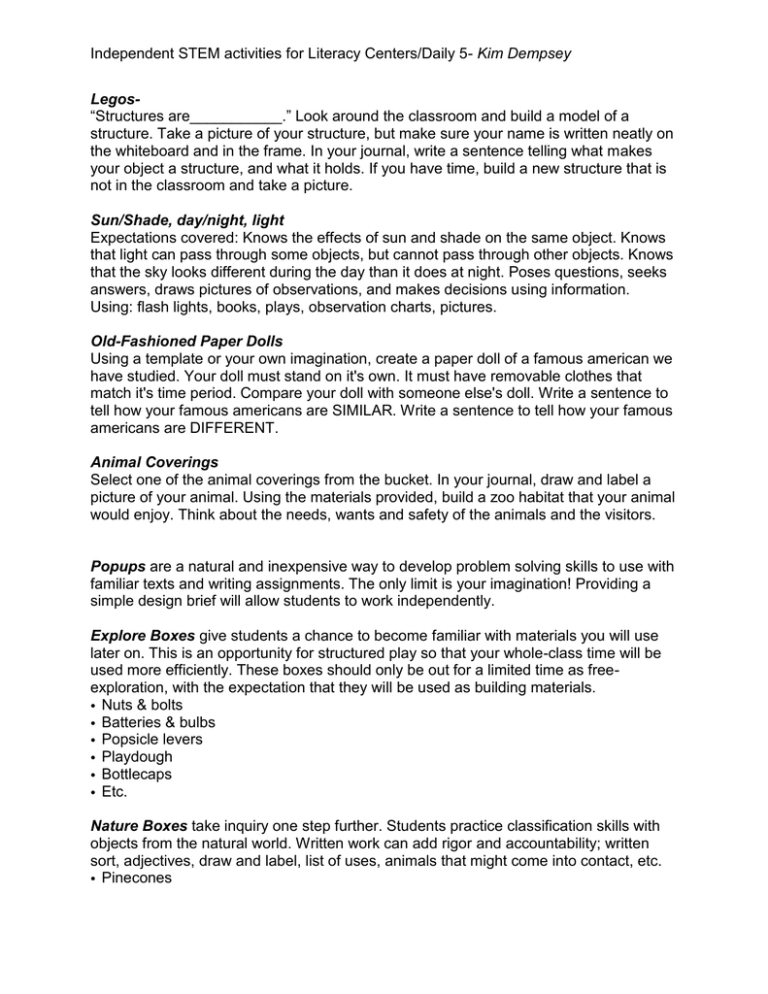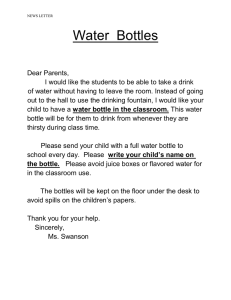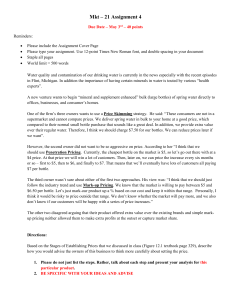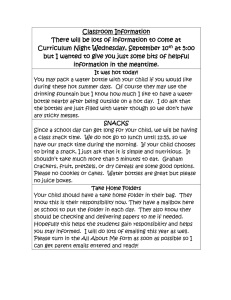Independent STEM activities for Literacy Centers/Daily 5- Kim Dempsey Legos-
advertisement

Independent STEM activities for Literacy Centers/Daily 5- Kim Dempsey Legos“Structures are___________.” Look around the classroom and build a model of a structure. Take a picture of your structure, but make sure your name is written neatly on the whiteboard and in the frame. In your journal, write a sentence telling what makes your object a structure, and what it holds. If you have time, build a new structure that is not in the classroom and take a picture. Sun/Shade, day/night, light Expectations covered: Knows the effects of sun and shade on the same object. Knows that light can pass through some objects, but cannot pass through other objects. Knows that the sky looks different during the day than it does at night. Poses questions, seeks answers, draws pictures of observations, and makes decisions using information. Using: flash lights, books, plays, observation charts, pictures. Old-Fashioned Paper Dolls Using a template or your own imagination, create a paper doll of a famous american we have studied. Your doll must stand on it's own. It must have removable clothes that match it's time period. Compare your doll with someone else's doll. Write a sentence to tell how your famous americans are SIMILAR. Write a sentence to tell how your famous americans are DIFFERENT. Animal Coverings Select one of the animal coverings from the bucket. In your journal, draw and label a picture of your animal. Using the materials provided, build a zoo habitat that your animal would enjoy. Think about the needs, wants and safety of the animals and the visitors. Popups are a natural and inexpensive way to develop problem solving skills to use with familiar texts and writing assignments. The only limit is your imagination! Providing a simple design brief will allow students to work independently. Explore Boxes give students a chance to become familiar with materials you will use later on. This is an opportunity for structured play so that your whole-class time will be used more efficiently. These boxes should only be out for a limited time as freeexploration, with the expectation that they will be used as building materials. • Nuts & bolts • Batteries & bulbs • Popsicle levers • Playdough • Bottlecaps • Etc. Nature Boxes take inquiry one step further. Students practice classification skills with objects from the natural world. Written work can add rigor and accountability; written sort, adjectives, draw and label, list of uses, animals that might come into contact, etc. • Pinecones Independent STEM activities for Literacy Centers/Daily 5- Kim Dempsey • • • • • Rocks Shells Animal Bones (cleaned with bleach) Insects Body coverings Thematic Centers are a tried-and-true instructional model. Take it to the next level by incorporating digital cameras to document work, providing a design challenge, and including books on the topic. Teachers may also incorporate writing in each of these activities. Teachers may also provide written index card challenges "What happens if you..." (students make predictions, then conduct experiments). Non-readers can benefit from tape-recorded directions Land/air/water and environments Expectations covered: Knows that life occurs on or near the surface of the Earth in land, water and air. Knows that plants and animals are found in different kids of environments and are often hidden. Using: books, plays, stuffed animals, pictures. Sun/Shade, day/night, light Expectations covered: Knows the effects of sun and shade on the same object. Knows that light can pass through some objects, but cannot pass through other objects. Knows that the sky looks different during the day than it does at night. Poses questions, seeks answers, draws pictures of observations, and makes decisions using information. Using: flash lights, books, plays, observation charts, pictures. Seasons, day sky, night sky Expectations covered: Knows that the position of the Sun in the sky appears to change during the day. Knows some of the objects seen in the night sky. Understands that continuous patterns occur in nature. Using: seasonal calendars, books, poems, plays, mini-books. Building with Different Mediums The students will explore different concepts of build. They will build with blocks, straws, popsicle sticks and magnets. They will document their buildings and recommend building methods to their peers. Building with Lunch Milk Cartons The students will explore different concepts of building with milk cartons. They will come up with strategies to build the tallest tower and create them. They will document their building methods and report to their peers. Planting Seeds The students will plant seeds, observe their growth and document their observations. This can easily be done with soil, seeds and plastic cups. Independent STEM activities for Literacy Centers/Daily 5- Kim Dempsey Terrarium The students will plants seeds in a terrarium environment. This will help them learn about how different systems can be self-sufficient. This will also give them a concrete way to observe roots, stem, leaves, and flowers. Terrariums can be made in clean water bottles. This way each student can take one home and have a great hands on experience in science centers. Temperatures in Different Conditions The students will use thermometers to discover the temperature of different areas of the classroom. What’s the temperature in ice, water, air, by the computers, etc… The temperature can be recorded on a chart and discussed as a large group after all students have been to the science center. Magnetic Vs. Non-Magnetic The students will learn what materials are magnet through the use of discovery bottles, toys and books. To create magnetic vs. non-magnetic bottles, fill a bottle ½ full of sand, add nails, pins, pipe cleaners, paperclips, toys, cotton balls or other small items. Provide the children with magnets and see if they are attracted. Push / Pull The students will learn about push and pull on different objects.Provide students with toys cars, balls, toy wagons, and other objects that require a push or pull to move. Have the children sort them into groups, and test which take a bigger push or pull. Cold / Ice The students will learn about the effect of cold / ice on different items. What’s the effect of ice on water, toys, crayons, and other items found in a classroom? Sort them into items that changed, and items that did not change. Rocks, Clay, Sand, Soil, Mud In these science centers the students will learn about the different properties of rocks, clay, sand, soil and mud. The children can use discovery bottles to help in this exploration. To make a sand bottle, add sand and water. Watch how it settles. To make a mud bottle, add ½ cup of dirt, 2/3 full of water. (Soil from different locations acts differently) Beach, Desert, Ocean, and other Terrains The students will learn about different terrains. The children can use discovery bottles to help in this exploration along with pictures, toys and books. To make a beach bottle, mix sand and shells. To make a desert bottle place plastic animals, sand, and cactus together. To make an ocean bottle fill the bottle ½ full of mineral oil, ½ full of water, and a few drops of food coloring. Independent STEM activities for Literacy Centers/Daily 5- Kim Dempsey Effect of the Sun on Earth The students will explore shadows on the surface of the Earth by using a globe and flashlight. They will also explore how different parts of the Earth are warm and others cold. Day Time Sky The students will study the day-time sky through books, pictures and observations. They will create 3D “day” pictures with magazines, clay, and other resources. Night Time Sky The students will study the night-time sky through books, pictures and observations. They will create 3D “night” pictures with magazines, clay, and other resources. Insects The students will learn about insects through books, pictures and real insects. The children will help collect dead insects in the weeks before this lesson. They will be placed into plastic cases for observation purposes. They will learn about the parts of an insect’s body and living habitats in these science centers. Living Vs. Non-Living The students will explore the idea that there are living and non-living things on Earth. They will use discovery bottles, pictures and books. Camouflage bottles The students will learn about camouflage through books, pictures and discovery bottles. In your science centers you can create camouflage bottles by placing many items that are the same color into a bottle. You can also make non-examples with several items that are the same color and then one item that isn’t. Paper Vs. Plastic The students will learn about recycling and how most communities recycle paper and plastic items. The children will sort materials for recycling and create recycling posters to hang around the school. 5 Senses The students will learn about the 5 senses. To do this the children will use books, pictures and discovery bottles. Touch: Put cotton balls or small toys into the bottles and have children grasp and pull out. Sight: Fill a bottle with corn syrup, add google eyes. Watch! Smell: Poke holes in bottle and add potpourri. Smell. Hearing: Put rice, beans, water, etc. in bottle. Wrap in a sock and shake. What’s that sound?






